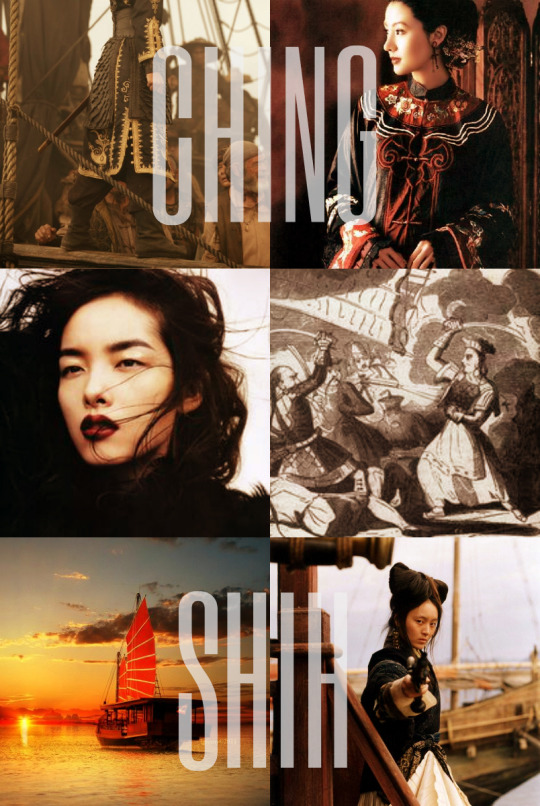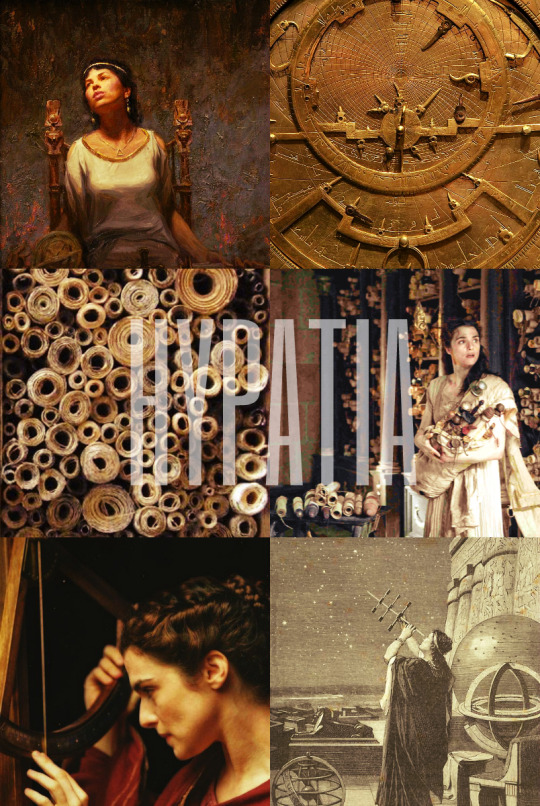Note
Hi! Super random question but I was wondering where you got the Greek spelling of "Hypatia" that is on the post you made about her. I am going to be getting a tattoo of her name in Greek, and I've seen different versions of how it is spelled. If you could possibly help me out that would be great! if you know any sources that I could verify that with that could help too!
Hi! Wow, that idea is really cool! Honestly, I just got it from Wikipedia :P I did take Ancient Greek in high school and Ὑπατία would probably be the proper spelling as far as I know (it might be different in modern Greek though), but I’m no expert or anything :) Good luck with getting your tattoo!
3 notes
·
View notes
Photo

Source Click HERE to Follow the Ultrafacts Blog!
704K notes
·
View notes
Text
I know it’s been a while since I posted on this blog. I’ve been very busy with school and I became a bit tired of the format of this blog. But then I was like, ‘this is my blog and I can do whatever the hell I want’, so I'm going to change things up a little:) Same concept, different execution or something like that! :)
5 notes
·
View notes
Photo

Charlotte Corday (1768-1793) Marie-Anne Charlotte de Corday d'Armont
Charlotte Corday is mostly known for the assassination of Jacobin leader Jean-Paul Marat, who had a key role during the Reign of Terror, by stabbing him to death in the bathtub.
Charlotte began sympathizing with the Girondins after the French revolution began to head towards terror. They were skeptical towards this path, and were opposed to the Montagnards, who advocated a more radical and violent approach towards the revolution, including the idea that the only way to avoid a civil war was to terrorize and execute anyone opposed to the revolution. Marat was one of the most radical Montagnards.
Charlotte’s decision to kill Marat was motivated by her revulsion at the September Massacred and fear for a civil war. She believed Marat’s death would end violence throughout the nation. However, this was not the case: Marat became a martyr. In 1793, 4 days after the assassination, she was executed.
57 notes
·
View notes
Photo

Theodora Θεοδώρα (c. 500 - 548)
Theodora was one of the most influential and powerful empresses of the Byzantine Empire.Theodora worked as an actress and prostitute, and made quite a name for herself. When she was 16 she travelled to North Africa, Alexandria and Antioch. In 1522 she returned to Constantinople and began working as a wool spinner. She drew the attention of the heir of emperor Justin, Justinian, but he was not allowed to marry her because she was an actress.
However, when empress Euphemia, Justin's wife, died in 1525, Justin repealed the law and Justinian and Theodora married. She had already a daughter at this point who Justinian treated as legitimate (it is uncertain whether it was his child or not).
In 532 the two rival political factions, the Blues and the Greens, started a riot in the hippodrome during a chariot race.The rioters proclaimed a new emperor, Hypatius, nephew of a former emperor. Justinian and his officials wanted to flee, but Theodora spoke out against leaving the palace, saying dying as a ruler was better than living in exile. Her speech convinced everyone, and Justinian ordered his troops to attack the mob, killing many of the rebels as well as the false emperor, at Theodora's insistence. Justinian never forgot it was Theodora who saved his reign.
After the revolt, Theodora and Justinian rebuilt and reformed Constantinople, by building aqueducts, bridges and churches, the greatest of these being the Hagia Sophia. Theodora created her own centers of power, participated in Justinian's legal and spiritual reforms and increased the rights for women. She prohibited forced prostitution, expanded rights of women in divorce and the owning of property, instituted the death penalty for rape, gave mothers guardianship rights, and forbade the killing of adulterous women. Theodora died at the age of 48 of some kind of cancer or tumor, but her influence on the heartbroken Justinian was lasting, and he continued her work after she was gone.
56 notes
·
View notes
Photo

Sacagawea (c. 1788-1812)
Sacagawea was a Lemhi Shoshone woman who was part of the Lewis and Clark Expedition as a guide and interpreter, traveling from North Dakota all the way to the Pacific Ocean between 1804 and 1806. Sacagawea was born into the Agaidika tribe of the Lemhi Shoshone in Idaho, but was kidnapped by the Hidatsa tribe when she was about twelve, and was taken to a Hidatsa village in North Dakota. She became the wife of Toussaint Charbonneau, a French Canadian trapper, and was pregnant with her first child by him when captains Meriwether Lewis and William Clark arrived in the village. Charbonneau was hired as an interpreter, and Sacagawea was chosen to accompany them because they thought her knowledge of the Shoshone language would be useful. They moved into the expedition's fort and here she gave birth to her son, Jean-Baptiste. In April 1805 the expedition left the fort and headed up the Missouri river, and Sacagawea and her newborn baby traveled with them. She proved to be very useful to the expedition. Sacagawea knew how to find edible plants,and when Sacagawea rescued journals and records of the expedition that had fallen out of the boat, the commanders named the Sacagawea river after her.
Later, the corps met a Shoshone tribe and tried to trade horses, using Sacagawea as an interpreter. She discovered that the chief was her brother, and after this reunion the Shoshone agreed to trade horses and provide the expedition with guides to lead them over the Rocky Mountains.
After reaching the Pacific coast in November 1805, Sacagawea was allowed to vote along with the other members of the expedition on where they would build their winter fort. In March of the next year, the expedition returned and Sacagawea, her husband and her son remained with them until they reached the Mandan villages. Clark had become very fond of her son, and even offered to pay for his education.
There is not a lot known about her life after the expedition. It is believed she traveled with her son and husband to St. Louis to meet Clark, and the boy was left in Clark's care. Three years later, Sacagawea gave birth to her daughter, Lisette. She reportedly died around 1812, and after her death Clark looked after her two children and took custody of them both.
112 notes
·
View notes
Photo


THE FORTY ELEPHANTS
The ‘Forty Elephants’ or ‘Forty Thieves’ were a London-based all-female crime syndicate in existence from at least the 19th century until the 1950’s. The gang specialised in shoplifting expensive clothes and jewelry worth thousands of pounds, dressing in coats, skirts and hats with hidden pockets to hide their loot. The women also used false references to work as housemaids and steal from their employers homes, and they blackmailed men after seducing them.
They tried to live the lives of glamorous movie stars and the 1920s flapper society, giving extravagant parties, spending money in restaurants and wearing designer clothes (they didn’t wear the clothes they stole, but sold them) . The leader or ‘queen’ of the gang during part of the 1910’s and 20’s, the haydays of the gang, was Diamond Annie, called this because she punched people with a fist full of diamond rings. By this time most of London knew the gang, their raids were getting more fearless, and they used fast cars to get away. Diamond Annie herself was jailed in 1925 for taking revenge on a male crook, but continued leading the gang from prison until the 30’s.
#made this for my main blog#but it fits on here as well#forty elephants#girl gang#history#1910's#1920's#photoset
18K notes
·
View notes
Photo

Ching Shih 鄭氏 (1775-1844) Cheng I Sao
Ching Shih was one of Asia's strongest pirates who terrorized the China Sea in the early 19th century. At the height of her power she commanded at least 1000 junks and 20.000 to 40.000 pirates.
Ching Shih was born in 1775 in the Guangdong province under the name of Shil Xiang Gu. She worked as a prostitute in the city Canton, but was captured by pirates and married Zheng Yi, a famous pirate. She participated in her husbands piracy, and together they made a coalition of Cantonese pirates, known as the Red Flag Fleet.
When Zheng Yi died in 1807, Ching Shih took over leadership. To stop her rivals she sought support of powerful members of her husbands family. She also made herself essential to the remaining captains of the Red Flag Fleet. When she needed someone loyal to help her manage the fleets daily operations, she chose Chang Pao, her husbands first mate. Ching Shih and Chang Pao eventually married and she had a child with him.
Ching Shih further united the Red Flag Fleet by making a code of very strict laws. Special rules were made for female captives: standard practice was to either release women or make them concubines or wives, but this was not allowed on Ching Shih's fleet. Pirates who raped the captives were executed, but if they had consensual sex with captives, both the pirate and the woman would be killed.
The fleet took control over many coastal villages, sometimes even imposing levies and taxes. The Chinese, Portugese and British navies all tried to defeat Ching Shih, but none succeeded, so eventually in 1810 they offered amnesty to all pirates. Ching Shih began negotiations with government official Zhang Bai Ling and got everything she asked for: she even could keep her loot. Ching Shih then ended her career, and returned to Canton after Chang Pao's death with her son to open a gambling house, becoming one of the few pirate captains to retire from piracy. She eventually died of old age at 69.
#ching shih#pirates#chinese history#awesome ladies of history#history#myedits#sorry this took so long#busy time at uni
306 notes
·
View notes
Photo

Catherine The Great Екатерина II Великая (1729-1796) Sophie Friederike Auguste
Catherine the Great was a Russian empress, whose reign is often called the Russian golden age. She was born as Sophie Friederike Auguste, a German princess from an impoverished family. When she was married in 1745 to grand duke Peter, the heir of the Russian empire, she took the name Catherine or Jekaterina, along with her new Russian Orthodox religion. She made up her mind to become completely Russian by studying the language, religion and culture.
The marriage between Peter and Catherine wasn't very good: Catherine found Peter immature, ans to pass the time she started reading a lot. Peter assumed the throne in 1761 and Catherine became empress consort. Because the couple were mostly leading separate lives by then and Peter had more interest in his mistress than in his wife, she didn't have much to do with his rule. However, Peter was neurotic, rebellious, and a supporter of Frederick II of Prussia, which alienated the nobles and military and drove them to Catherine. Meanwhile, Catherine conspired with her lover, Gregory Orlov, and several others, to depose Peter. She not only had noble and military support, but public opinion in Moscow and St. Petersburg was also in favour of her. The coup succeeded and on June 28, 1762, Catherine proclaimed herself empress. Peter abdicated and was assassinated three days later. (Although she probably wasn't responsible for this, public opinion thought she was.)
Catherine had big ambitions for Russia. During her reign, she extended the borders to absorb Crimea, the Caucasus, Belarus, Lithuania, among others, adding 200,000 square miles of territory, mostly at the expense of the Ottoman Empire. She also tried to be an Enlightened sovereign, and was a patron of the arts, literature and education. She wrote fiction and memoirs herself, studied and corresponded with the French Enlightenment philosophers. However, she failed in trying to embody the Enlightenment ideals in legislation and an education programme. She did succeed in founding the Smolny Institute for Noble Girls to educate women. However, her numerous economic, military and cultural projects needed a lot of money, and the many peasants and serfs of Russia had to finance this with their labour, so their situation was worse at the end of Catherine's rule than it had been before. When the situation was worsened by plague and crop failure, it led to Pugachev's rebellion in 1774, although the rebellion didn't succeed.
The love life of Catherine and her sexual independence has led to a lot of speculation. Although the rumours of bestiality are definitely not true, she did have numerous lovers during her reign, but marrying again would jeopardize her position. She did have children and grandchildren, including her heir Paul, who was probably Peter III's son, and with whom she had a strained relationship. Catherine died in 1796 of natural causes. She is often better remember for her romantic life than her accomplishments, and she is often criticized for not improving the life of serfs. But she made some very big contributions to Russia and put it on the map when it was still seen as a backwards country.
#catherine the great#catherine II#enlightenment#queens#history#russia#awesome ladies of history#photoset#myedits
28 notes
·
View notes
Photo

Boudica (?- 60/61 AD) Boadicea
Boudica was a Celtic queen of the British Iceni tribe. Her husband, Pratusagus, had an agreement with the Roman Empire: he had voluntarily allied the tribe to the Empire, in return for independence. He made the Roman emperor co-heir to his kingdom, along with his wife and two daughters. But when he died, his wish that Boudica and their daughters would also inherit, was ignored. The lands and property were confiscated, Boudica was flogged and her daughters were raped.
In 60 or 61 AD, the governor Gaius Suetonius Paulinus was leading a campaign against the island of Mona, a refuge for British rebels. The Iceni conspired with a neighbouring tribe, the Trinovantes, to revolt, and Boudica was chosen as their leader. They attacked the colonia Camulodunum, the former capital of the Trinovantes. The city was poorly defended and only 200 auxiliary troops were sent by the Romans, so Boudica was able to destroy the city after two days of siege. The future governor and commander of the Legio IX Hispana, Quintus Petullius Cerialis, tried to relieve the city, but was defeated. When the news of the rebellion reached Gaius Suetonius, he went to Londinium, a new and thriving commercial city, but eventually he did not dare to give battle there and abandoned the city. Boudica and the rebels burned the city down and killed everyone who had not evacuated. The revolt killed 70,000 Romans and destroyed not only Camoludunum and Londinium, but also Verulamium and several military posts.
Suetonius regrouped his forces somewhere along the Roman road known as Watling Street, but he was outnumbered. Boudica commanded her troops from her chariot with her daughters beside her. Hoewever, the Britons were less skilled at open combat and their equipment and discipline was not as good as that of the Romans. Eventually, they were defeated. Sources differ about what happened to Boudica: some say she poisoned herself after the defeat, others say she fell sick and died.
#boudica#this one took so long#and i'm still not completely happy with it#oh well#boudicca#boadicea#queens#celtic#ancient history#history#awesome ladies of history#photoset#myedits
536 notes
·
View notes
Photo

Ana Nzinga Mbande (1583-1663) Ana de Sousa Nzinga Mbande
Nzinga Mbanda was a powerful ruler of the kingdoms of Ndongo and Matamba (modern-day Angola). She fought for the freedom of her kingdoms against the colonizing Portuguese in a period when the Atlantic slave trade was growing rapidly.
Portuguese troops invaded the kingdom of Ndongo in 1617. Thousands of people were taken prisoner and king Ngola Mbandi, Nzinga's brother, was forced to flee the capital. Four years later, Nzinga was sent by her brother to negotiate a peace treaty with the Portuguese governor. According to a famous story, the governor did not offer her a chair to sit in, to show his superiority over her. As a response, she ordered one of her servants to kneel on the ground so she could sit on his back during the negotiations, thereby asserting her equal status.
However, the Portuguese didn't honour the peace treaty, and as a result of this, the king commited suicide. Nzinga took control as regent over his son Kaza, but she allegedly killed him for impudence, and from 1626 on she called herself Queen of Andongo. Nzinga re-entered negotiations with the Portuguese and converted to Christianity, taking the name Ana de Sousa Nzinga Mbande. However, the peace treaty again didn't last long and Nzinga was forced to flee Ndongo. During this time she took over the kingdom of Matamba and joined it to the kingdom of Ndongo. To build her army she offered refuge to runaway slaves and Portuguese trained African soldiers, she stirred up rebellion among the people who were still living in Ndongo under Portuguese rule and she made an alliance with the Dutch against the Portugal. In 1644 she defeated the Portuguese army at Ngoleme, but she was unable to follow up this victory. Her sister, who had been spying for Nzinga, was captured and allegedly killed by the Portuguese, and Nzinga retreated to Matamba, although she continued to resist Portugal and lead her army into battle.
She finally signed a peace treaty with Portugal in 1657 and she focused her attention on rebuilding her nation, and she died a peaceful death of old age four years later. Nowadays, she is remembered for her political and diplomatic skill, her intelligence and her military tactics.
#nzinga mbande#ana de sousa#african#queens#angola#history#awesome ladies of history#photoset#myedits
42 notes
·
View notes
Photo

Khutulun (ca. 1260-1306) The Wrestler Princess
Khutulun was the most famous and favourite daughter of Kaidu, who was the most powerful ruler of Central Asia. Khutulun was a great warrior, and was able to ride into enemy ranks and snatch captives with amazing speed. She assisted her father in battles against the Yuan Dynasty of Kublai Khan, her uncle, and he often asked her for advice and support.
She is perhaps most famous for her insistence that she would only marry a man who would be able to defeat her in wrestling: if the man lost, he would have to give her his horse. It is said that she gained 10.000 horses this way. However, eventually she decided to marry one of her fathers followers without wrestling him, to protect her and her father from rumours about an incestuous relationship between the two of them.
Some accounts say Kaidu tried to make Khutulun his successor before he died, but because she had male relatives this didn't happen. Khutulun and her brother Orus guarded her fathers tomb after he died, and was challenged by her other brothers because she resisted their succession. She died in 1306, and is remembered in Mongol culture as a great athlete and warrior.
727 notes
·
View notes
Note
Can you please do a set of Boudica? It would kind of make my life.
I'm working on a few other sets first, but as a very very awesome lady she's definitely on my list! So it won't be long :)
0 notes
Photo

Anne Frank (1929-1945)
Anne Frank was a Jewish girl who became famous after she died for the diary she wrote during the Second World War. Anne was born in Germany, but in 1933, the year the nazi's gained control over Germany, her family moved to Amsterdam. However, in 1940 the Netherlands became occupied by Germany, and when persecution of the Jews increased in 1942 the family went into hiding in the Achterhuis, some concealed rooms in the building where Anne's father worked.
Before they went into hiding, Anne received a diary for her 13th birthday on 12 June 1941, as Anne had always loved writing, and wanted to become an author or a journalist. She started by writing about her daily life, although she discussed some aspects of the German occupation as well. A month later, her older sister Margot received a notice ordering her to report for relocation to a workcamp, and they went into hiding.They were joined the next week by the Van Pels-family, and in November by another friend of the family. The only people who knew about the people in hiding were a few employees of the company. Anne wrote in her diary about life in hiding and the tensions that arose from living with a lot of feelings, sexuality, the relationships and the fights she had with her family,her beliefs and ambitions. As she became more mature, she also wrote on more abstract concepts, such as human nature.
The Achterhuis was stormed by the German uniformed police on 4 August. Three days later the Anne, her family and the other inhabitants were transported to the Westerbork transit camp, and on 3 September the group was transported to Auschwitz concentration camp. Anne, her mother and her sister were separated from Otto. Anne and Margot were transported to Bergen Belsen in October, but their mother was left behind and died. Anne and Margot died in Bergen Belsen during a tyfus epidemic, a few weeks before British troops liberated the camp. Of the Frank family, only Otto survived the war. Miep Gies, an employee who knew about the Achterhuis, had collected Anne's diary after the arrests. She gave it to Otto Frank when he returned and in 1947 it was published in Dutch as Het Achterhuis. It was quickly translated to other languages, and praised for its writing and commentary on the war. Today, Anne Frank is seen not just as an energetic, extroverted and precocious young girl, but also as a representative or symbol for the millions of Holocaust victims.
#anne frank#sorry this one is so sad#but anne is a great inspiration to me#i can only imagine what she would have become had she lived longer#holocaust#history#writers#awesome ladies of history#in spite of everything I still believe that people are really good at heart
28 notes
·
View notes
Photo

Hatshepsut (c. 1508-1458 BC) Ma'atkare
Hatshepsut was the fifth pharaoh of the Eighteenth Dynasty of Egypt. She is regarded one of Egypts most succesful pharaohs. At first she ruled as queen alongside her husband and halfbrother, Thutmose II, but when he died she took over as regent for her stepson, Thutmose III. However, she proclaimed herself pharaoh within a few years. She depicted herself as male, with the traditional clothes, false beard and male body: not to trick people into thinking she was a man, but to assert her royal authority.
Egypt prospered under Hatshepsut's reign: she wasn't very interested in conquering new lands, but instead she ensured economic prosperity and built and restored monuments all over Egypt. She established trade networks and organised a mission to the land of Punt, which returned with frankincense, gold, ivory and myrrh. She built an enormous memorial temple at Deir el-Bahri, which is now regarded as one of the architectural wonders of the ancient world.
Sadly, a lot of the monuments Hatshepsut contructed were destroyed after she died in 1458 BC and Thurmose III came into power.
#hatshepsut#try saying that ten times#queens#ancient egypt#definitely more awesome than cleopatra and nefertiti#although they were awesome as well#history#awesome ladies of history#myedits
458 notes
·
View notes
Photo

Hypatia Ὑπατία (350-415 AD)
Hypatia was a Greco-Egyptian mathematician and philosopher from Alexandria. Her father was the philosopher Theon Alexandricus, who taught her mathematics and astronomy. She was educated at Athens and became a very important philosopher within the Neoplatonist school in Alexandria around 400 AD. She taught the knowledge of Plato and Aristotle in the Museum, a sort of university, whose immense collection of scrolls was stored in the library of Alexandria. She taught students of different religions and ethnicities and also held public lectures, which were very popular and actually drew crowds. Her lessons also included how to design an astrolabe, an astronomical calculator that would be in use until the 19th century.
Alexandria was a place of religious conflict during the life of Hypatia. Orestes, the governor, and Cyril, the archbishop, were fighting over who controlled the city: althought both were Christians, Orestos didn't want to cede power to the church. Pagans and Jews were also mixed up in the conflict, and the struggle for power and religious unrest reached its peak after a massacre of Christians by Jewish extremists. Hypatia was an easy target in the struggle: she was a pagan who spoke about Neoplatonism, a non-Christian philosophy, she was an associate of Orestes and a very public figure, but she didn't have the protection Orestes had. It is said that Cyril's preaching incited a fanatical Christian mob to brutally murder her, although the exact involvement of Cyril is uncertain. But the Neoplatonic school she headed continued in Alexandria until 642, when the Arabs invaded and burned the library of Alexandria, including Hypatia's works.
358 notes
·
View notes
Photo

Joan of Arc/Jeanne d'Arc (1412-1431) The Maid of Orléans
Joan was born a peasant girl inorth-east France. When she was twelve, she believed she had visions of the Archangel Michael, Saint Margaret and Saint Catherine, who told her to recover France from the English at the end of the Hundred Years War and to bring Charles VII to Reimes for his coronation. Four years later, she gained an audience with the king after telling a garrison commander about the defeat of the French at Orléans, days before the news arrived by messengers. She travelled to the royal court at Chinon, disguised as a soldier. A desperate Charles VII accepted her military services. The test to the truth of her claims of divine inspiration would be the raising of the siege of Orléans. There is some doubt about the actual extent of her military participation and leadership: Joan stated she preferred to carry her banner, but the commanding noblemen also said they often took the advise she gave them and she had great effect on their decisions.
In just nine days the siege of Orléans was lifted. Afterwards, she gained permission to recapture nearby bridges along the Loire to prepare for an advance on Reims and the coronation of Charles. The campaign was a huge succes and the king was crowned on 17 july 1429. After the coronation, she fought in other battles against the English and was raised to nobility along with her family.
Joan was finally captured by the Burgundians at Compiègne, a city she helped defend against English and Burgundian siege. The English obtained her from the Burgundians and moved her to Rouen. There were several attempts to rescue her, but none succeeded. Joan was put on trial for heresy and crossdressing, but the tribunal was composed entirely of pro-English and Burgundian clerics and the procedure was illegal in a number of ways. She was executed by being burned on 30 May 1431. After the Hundred Years War ended, she was declared innocent in a retrial, and in 1920 she was canonized as a Catholic saint.
#joan of arc#jeanne d'arc#history#photoset#awesome ladies of history#a bit longer than usual#and I deleted like half of what I wrote#she's a bit of a childhood hero to me :)#myedits
19 notes
·
View notes